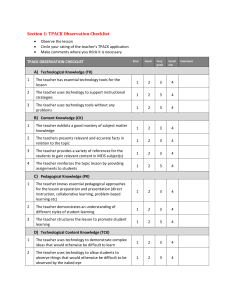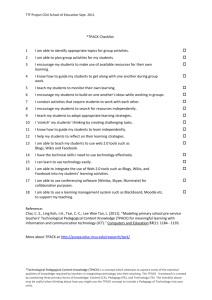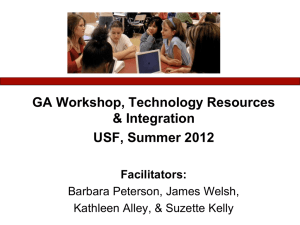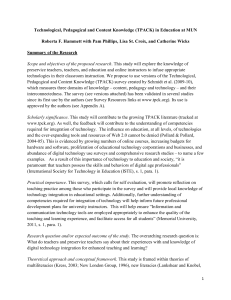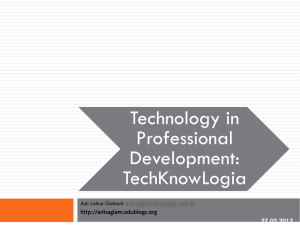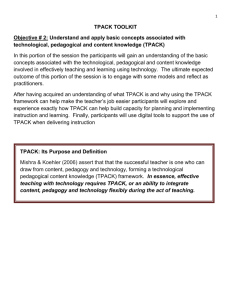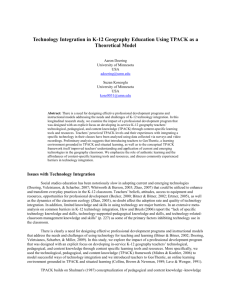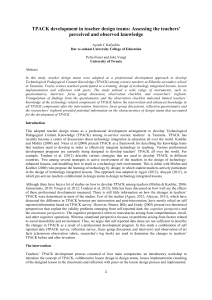Supporting teachers` collaboration in design teams to
advertisement
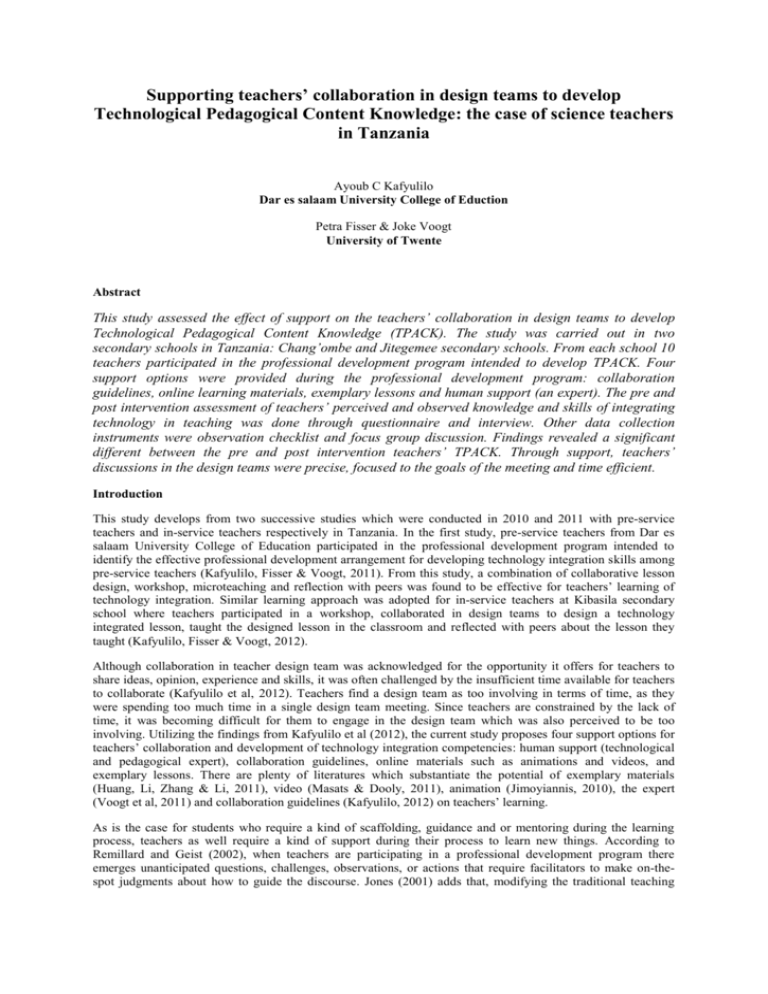
Supporting teachers’ collaboration in design teams to develop Technological Pedagogical Content Knowledge: the case of science teachers in Tanzania Ayoub C Kafyulilo Dar es salaam University College of Eduction Petra Fisser & Joke Voogt University of Twente Abstract This study assessed the effect of support on the teachers’ collaboration in design teams to develop Technological Pedagogical Content Knowledge (TPACK). The study was carried out in two secondary schools in Tanzania: Chang’ombe and Jitegemee secondary schools. From each school 10 teachers participated in the professional development program intended to develop TPACK. Four support options were provided during the professional development program: collaboration guidelines, online learning materials, exemplary lessons and human support (an expert). The pre and post intervention assessment of teachers’ perceived and observed knowledge and skills of integrating technology in teaching was done through questionnaire and interview. Other data collection instruments were observation checklist and focus group discussion. Findings revealed a significant different between the pre and post intervention teachers’ TPACK. Through support, teachers’ discussions in the design teams were precise, focused to the goals of the meeting and time efficient. Introduction This study develops from two successive studies which were conducted in 2010 and 2011 with pre-service teachers and in-service teachers respectively in Tanzania. In the first study, pre-service teachers from Dar es salaam University College of Education participated in the professional development program intended to identify the effective professional development arrangement for developing technology integration skills among pre-service teachers (Kafyulilo, Fisser & Voogt, 2011). From this study, a combination of collaborative lesson design, workshop, microteaching and reflection with peers was found to be effective for teachers’ learning of technology integration. Similar learning approach was adopted for in-service teachers at Kibasila secondary school where teachers participated in a workshop, collaborated in design teams to design a technology integrated lesson, taught the designed lesson in the classroom and reflected with peers about the lesson they taught (Kafyulilo, Fisser & Voogt, 2012). Although collaboration in teacher design team was acknowledged for the opportunity it offers for teachers to share ideas, opinion, experience and skills, it was often challenged by the insufficient time available for teachers to collaborate (Kafyulilo et al, 2012). Teachers find a design team as too involving in terms of time, as they were spending too much time in a single design team meeting. Since teachers are constrained by the lack of time, it was becoming difficult for them to engage in the design team which was also perceived to be too involving. Utilizing the findings from Kafyulilo et al (2012), the current study proposes four support options for teachers’ collaboration and development of technology integration competencies: human support (technological and pedagogical expert), collaboration guidelines, online materials such as animations and videos, and exemplary lessons. There are plenty of literatures which substantiate the potential of exemplary materials (Huang, Li, Zhang & Li, 2011), video (Masats & Dooly, 2011), animation (Jimoyiannis, 2010), the expert (Voogt et al, 2011) and collaboration guidelines (Kafyulilo, 2012) on teachers’ learning. As is the case for students who require a kind of scaffolding, guidance and or mentoring during the learning process, teachers as well require a kind of support during their process to learn new things. According to Remillard and Geist (2002), when teachers are participating in a professional development program there emerges unanticipated questions, challenges, observations, or actions that require facilitators to make on-thespot judgments about how to guide the discourse. Jones (2001) adds that, modifying the traditional teaching techniques to incorporate technology is not easy; it takes time, which teachers often lack (cf. Voogt, Tilya & van den Akker, 2009). In order for teachers to effectively use the little time more efficiently, they need a close support (Higgins & Spitulnik, 2008; Remillard & Geist 2002). According to Voogt et al (2011), the presence of a support for collaboration can prevent negative results of professional learning in teams. The professional development arrangement The study involved a pre and post intervention assessment of teachers’ knowledge and skills of integrating technology in teaching. Pre-intervention activities included; teachers’ participation in the face to face interview with the researcher and filling out a questionnaire. This was followed by a workshop to introduce the concept of Technological Pedagogical Content Knowledge (TPACK) and the idea of collaboration in design teams to design technology integrated lessons. To help teachers collaborate effectively, collaboration guidelines were introduced to teachers immediately after the first workshop. In addition to guidelines, teachers were trained on how to search and download online learning materials from YouTube and other free sites such as Kscience. Teachers also observed and discussed the exemplary lessons which were designed and used by other teachers from other schools. A summary of the activities carried out during the professional development program is presented in Table 1. Table 1 A summary of the activities carried out during the professional development program Activity Workshop Lesson design in design teams Lesson implementation 1st reflection workshop Lesson re-design Lesson reimplementation Aim Introduction of the concept of TPACK Discussion about collaborative lesson design in teacher design teams Introduction of collaboration guidelines Practices with various online learning materials Review of exemplary lessons Use of exemplary lessons to prepare technology integrated lessons Learning from each other and from the expert Searching and downloading relevant online learning materials Design of technology integrated lessons Teaching the designed lesson in the classroom Practicing the use of a projector and laptop in teaching Assessing the teachers’ practices with technology A workshop to reflect on the lesson design process and teaching of a technology integrated lesson in the classroom. Discussion on how to improve the lesson in the future A new lesson was designed, incorporating the ideas that were discussed from the first reflection workshop The newly designed lesson was taught in the classroom and assessed by the researcher Duration 4 days 3 weeks 1 day for each team 1 day 3 weeks 1 day for each team Research questions This study aimed to reveal the impact of support on teachers’ collaboration in design teams and development of knoweldge and skills of integrating technology in teaching. The main research question that guided the study was: What is the effect of support on teachers’ collaboration practices and the development of knowledge and skills of integrating technology in science teaching? This question was worked out by dividing it into two sub questions: 1. What support option is effective for teachers’ development of technology integration knowledge and skills in science teaching? 2. What technology integration knowledge and skills do teachers develop when they collaborate in teacher design teams? Methodology Participants This study was carried out at Chang’ombe and Jitegemee secondary schools in Tanzania. A total of 20 teachers; ten from each school participated in the design of technology integrated lessons. Three design teams were formed from each school, where all science (physics, chemistry and biology) teachers who were available at the Chang’ombe secondary were involved in the study while 12 teachers (4 for each subject) from Jitegemee secondary school were appointed by their heads of department to attend in the study. However, 2 teachers from biology and physics did not continue to the end. At least three teachers formed each of the design teams in both Chang’ombe and Jitegemee secondary schools. Teachers in design teams prepared technology integrated lessons taught them over 300 students. Instruments Five data collection instruments were used in this study: TPACK survey, support survey, interview, focus group discussion, and observation checklist. The TPACK survey was modified from Schmidt et al (2009) and Graham et al (2009) and was used to assess the teachers’ perceived TPACK before and after intervention. However, Content Knowledge, Pedagogical Knowledge and Pedagogical Content Knowledge were not assessed because these aspects were common to teachers. In addition, there were questions regarding the impact of each of the supports provided to teachers: these were developed by the researcher. The survey had a reliability of 0.81 Cronbach’s alpha. There was also an observation checklist which was modified from Graham et al, (2009), Harris, Grandgenett & Hofer (2010) and Tilya (2003) and was used to assess the teachers’ practices with technology in the classroom. The observation checklist was rated by the researcher and the expert in ICT integration. The inter-rater reliability was 0.83 Cohen Kappa. Interviews with teachers were held at the beginning (pre-intervention) and at the end (post intervention) of the professional development program. The pre-intervention interview was intended to reveal the teachers’ understanding of technology integration and collaboration in teacher design team. The post intervention interview was designed to assess the change in teachers’ knowledge and skills of technology integration as a result of intervention. Focus group discussion was administered at the end of the intervention to assess the impact of the support that was provided to teachers during lesson design in design teams. Results Support for collaboration in teacher design teams Teachers from both Chang’ombe and Jitegemee secondary schools were asked to indicate the support that was most important to their learning of technology integration and collaboration in design teams. Findings showed that, the expert was the most important support option for their learning in teacher design teams followed by the exemplary lessons (Table 2). Table 2: The impact of each support on teachers’ collaboration and learning of technology integration Supports Chang’ombe (N =10) 1st design 2nd design M (SD) M(SD) Jitegemee (N = 10) 1st design 2nd design M(SD) M(SD) Collaboration guidelines 4.38 (0.214) 4.64 (0.295) 4.25 (0.236) 4.54 (0.330) The expert 4.85 (0.139) 4.67 (0.601) 4.52 (0.663) 4.92 (0.126) Exemplary lessons 4.70 (0.302) 4.71 (0.362) 4.20 (0.466) 4.75 (0.278) Online materials 4.60 (0.239) 4.49 (0.527) 4.43 (0.128) Scale: 1 = strongly disagree, 2= disagree, 3 = neutral, 4 = agree and 5 = strongly agree 4.63 (0.358) As reported in Table 2, in the first lesson design teachers from both Chang’ombe and Jitegemee indicated high level of agreement towards the expert. However the two schools differed on the second best support; while Chang’ombe showed that exemplary lessons were the second best, Jitegemee showed that online learning materials were the best next to the expert. In the second design, teachers from Chang’ombe indicated high level of agreement with exemplary lessons, while teachers from Jitegemee showed high level of agreement towards the expert. From interview and focus group discussion, it was reported by teachers that all supports were equally important, each having its specific impact on teachers’ professional growth. Some of the support options were effective for the development of technology integration knowledge and skills, others in simplifying the lesson design process and others for effective collaboration in teacher design teams. The development of technology integration knowledge and skills in Teacher Design Teams Through participation in a teacher design teams, teachers reported to learn from each other and developed knowledge and skills of integrating technology in teaching. Findings from the TPACK survey revealed a significance difference between pre and post intervention teachers’ perceived knowledge and skills of integrating technology in teaching (Table 3). Table 3: Perceived pre and post intervention teachers’ technology integration competencies (N=20) PrePostintervention intervention TPACK Components and students’ learning M (SD) M (SD) Technological Knowledge 3.04 (0.78) 4.02 (0.43) Technological Pedagogical Knowledge 3.42 (0.87) 4.37 (0.37) Technological content Knowledge 3.22 (0.87) 4.26 (0.43) Technological Pedagogical Content Knowledge 3.31 (0.89) 4.30 (0.46) Technology integration competencies 3.04 (0.79) 4.12 (0.52) Scale: 1 = strongly disagree, 2 = disagree, 3 = neutral, 4 = agree, 5 = strongly agree P Effect size 0.001 0.001 0.001 0.001 0.001 1.54 1.42 1.51 1.37 1.61 Table 3 indicates that, prior to the participation in the professional development program; teachers perceived their technology integration competencies to be average (M ≤ 3.4 and high standard deviations between 0.8 and 0.9). After the intervention, teachers’ perceived their technology integration competencies to be high (M ≥ 4 and low standard deviations, SD < 0.5). Teachers believe that they gained their technology integration competencies after having participated in the collaborative lesson design in teacher design team. The expert and the researcher rated the teachers’ implementation of the lessons in the classroom. Results showed a significance change in TK, TPK and students learning outcomes, but insignificant in TCK and TPACK between the first and second lesson. Table 4 presents the Wilcoxon signed ranks test results between the first and second lesson implementation in the classroom. Table 4: Observed technology integration practices in the 1st and 2nd lesson teaching (N= 6) TPACK components and students’ learning 1st lesson 2nd lesson Z-score P Effect size M (SD) M (SD) Technological knowledge 2.42 (0.248) 2.56 (0.263) -0.921 0.357 0.55 Technological Content Knowledge 2.65 (0.328) 2.95 (0.105) -2.209 0.027 1.23 Technological Pedagogical Knowledge 2.47 (0.413) 2.90 (0.225) -2.565 0.010 1.29 Technological Pedagogical Content Knowledge 2.58 (0.322) 2.87 (0.172) -1.732 0.083 1.12 Scale: 1 = No, 2 = No/Yes, 3 = Yes Findings from Table 4 indicate a change between the first lesson implementation and second lesson implementation but the change was insignificant for TK and TPCK. Additionally, the effect sizes were large for TCK, TPK and TPCK, and moderate for TK. However, despite the insignificant changes in technology integration knowledge and skills between the first and second lesson, during interview with teachers, they indicated to have improved their understanding of the relationship between technology, pedagogy and content as they teach in the classroom. Conclusions and discussion In this study, four support options were offered to teachers; collaboration guidelines, online learning materials (pictures, videos and animations), exemplary lessons and the expert. From the findings it was revealed that all the support options were important in both the development of teachers’ technology integration competencies and collaboration in teacher design teams. However, the impact of each support was highly dependent on the kind of activities that teachers were carrying out. For example, in the process of designing a technology integrated lesson, teachers were highly dependent on the exemplary lessons, expert and the online materials. The collaboration guidelines were found to be important for teachers’ effective collaboration in teacher design teams. In both first and second lesson design, teachers indicated that the expert was the most important support for their collaboration and learning of technology integration in science teaching. Earlier findings by Bransford, Brown & Cocking (2000) indicate that, in the presence of an expert in the teacher professional development program, there is enhancement of teachers learning process through the increased communication between the expert and teachers. Findings from this study are in-line with those of Bransford et al (2000). In this study teachers indicated that the first and most important support to consult whenever they encountered a challenge in their lesson design was the expert. However, this does not mean that other support options were not important. Teachers indicated that, presence of online materials and exemplary lessons were very important to their learning but all together required a help from the expert for them to understand how to integrate with other competent of TPACK (pedagogy and content). Additionally, teachers reported to establish a strong and focused collaboration through the presence of collaboration guidelines which guided their collaboration in design teams. During interview with the researcher, teachers indicated that all support options were important, depending on the kind of lessons they designed and the learning component in the design team. To majority of teachers, when beginning to design the first lesson, they found the exemplary lessons most useful to their design process as they acted as model or benchmark for their design process (cf. Voogt, 2010). However, in the process, to design these lessons, they realized that the guidelines for collaboration were helping them to sticky to the purpose of their collaboration and easily learn from each other (cf. Kafyulilo, 2012). Moreover, teachers acknowledged the presence of online videos and animation for simplifying the lesson design process. Studies by Masats & Dooly (2011) also acknowledge the importance of videos in linking theory and practice, and bringing innovative and creative practices for teaching. In this study, online videos and animations are reported important in saving the time that teachers would have used for making animations or recording videos. The successful collaboration in the design team had a spectacular impact on the teachers’ development of technology integration competencies. Through participation in a collaborative design of technology integrated lessons, teachers were able to exchange ideas and knowledge from the team members and enhance their TPACK. Within a team, there were teachers who are good in technology, others in pedagogy and others in content. Every teacher had his/her contribution to the lesson design, either in content, pedagogy or technology, thus they were equally learning from each other. A good example is one of the chemistry teachers from Jitegemee who had never touched a computer in his life time, but he managed to make a PowerPoint presentation after the project. Other teachers developed abilities to search materials online and some new teaching approaches which are constructivist. In conclusion, both experienced and novice teachers in technology integration, reported to have learned from the professional development program. As revealed from the TPACK survey and classroom observation, there was a significant change in the perceived and observed teachers’ TPACK after the intervention. This leads us to a conclusion that, the supports provided to teachers during the collaborative lesson design in teacher design teams were effective in enhancing teachers’ knowledge and skills of integrating technology in teaching and thus, the development of TPACK. Reference Bransford, J., Brown, A. & Cocking, R. (2000). How people learn: Brain, mind, experience, and school. Washington, DC: National Research Council. Graham, C.R., Burgoyne, N., Cantrell, P., Smith, L., Clair, L. & Harris, R. (2009). TPACK development in science teaching: Measuring the TPACK confidence of inservice science teachers. TechTrends, 53(5), 70-79. Harris, J., Grandgenett, N. & Hofer, M. (2010). Testing a TPACK-based technology integration assessment rubric. In D. Gibson & B. Dodge (Eds.), Proceedings of Society for InformationTechnology & Teacher Education International Conference 2010 (pp. 3833-3840). Chesapeake, VA: AACE. Higgins, T. E. & Spitulnik, M. W. (2008). Supporting Teachers’ Use of Technology in Science Instruction Through Professional Development: A Literature Review. Journal of Science Education and Technology (17), 511–521 Huang, R., Li, Y., Zhang, J. & Li, Z. (2011). Improving teachers’ expertise in mathematics instruction through exemplary lesson development. ZDM Mathematics Education, (43), 805-817. Jimoyiannis, A. (2010). Designing and implementing an integrated technological pedagogical science knowledge framework for science teachers’ professional development. Computers & Education, doi:10.1016/j.compedu.2010.05.022. Jones, C. A. (2001). Tech Support: Preparing teachers to use technology. Principal leadership. Available at www.nassp.org/portals/o/content/48158.pdf accessed on 23rd July 2011. Kafyulilo, A.C. (2012). Collegiality in teacher design teams: experience from Tanzania and the Netherlands. Journal of Humanities, Education and Sciences, 1(1), 92 – 103. Kafyulilo, A.C, Fisser, P.H.G., & Voogt, J. (2011). ICT Use in Science and Mathematics Teachers’ preparation: Developing pre-service teachers’ TPACK. Paper presented at e-Learning Africa conference 25th -27th May, 2011 in Dar es salaam, Tanzania. Kafyulilo, A., Fisser, P. & Voogt, J. (2012). Transforming Classroom Practices through Teachers’ Learning of TPACK: The Case of In-service Teachers at Kibasila Secondary School in Tanzania. In P. Resta (Ed.),Proceedings of Society for Information Technology & Teacher Education International Conference 2012 (pp. 2861-2869). Chesapeake, VA: AACE Masats, D. & Dooly, M. (2011). Rethinking the use of video in teacher education: A holistic approach. Teaching and Teacher Education, (27), 1151-1162. Remillard, J.T. & Geist, P. K. (2002). Supporting Teachers’ Professional Learning by Navigating Openings in the Curriculum. Journal of Mathematics Teacher Education (5), 7–34. Schmidt, D., Baran, E., Thompson, A., Koehler, M.J., Mishra, P., & Shin, T. (2009, March). Examining preservice teachers’ development of technological pedagogical content knowledge in an introductory instructional technology course. Paper presented at the 2009 International Conference of the Society for the Information and Technology & Teacher Education. Charleston: South Carolina. Tilya, F. (2003). Teacher support for the use of MBL in activity-based physics teaching in Tanzania. Doctoral dissertation, Enschede: University of Twente. Voogt, J. (2010). A blended in-service arrangement for supporting science teachers in technology integration. Journal of Technology and Teacher Education, 18(1), 83-109. Voogt, J., Tilya, F., & van den Akker, J. (2009). Science teacher learning for MBL-supported student-centered science education in the context of secondary education in Tanzania. Journal of Science and education and technology, (18), 429-428. Voogt, J., Westbroek, H., Handelzalts, A., Walraven, A., McKenney, S., Pieters, J., & de Vries, B. (2011). Teacher learning in collaborative curriculum design, Teaching and Teacher Education, (27), 12351244.
